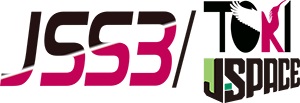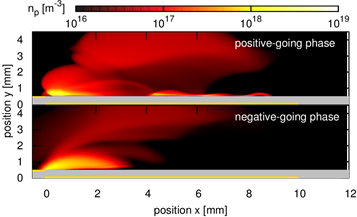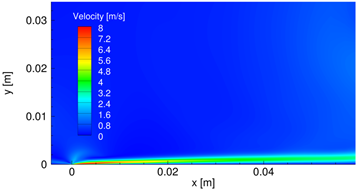Numerical analysis of discharge process for clarification of body force characteristics in DBD plasma actuator
JAXA Supercomputer System Annual Report April 2016-March 2017
Report Number: R16E0050
- Responsible Representative: Naofumi Ohnishi(Tohoku University)
- Contact Information: Naofumi Ohnishi(ohnishi@rhd.mech.tohoku.ac.jp)
- Members: Naofumi Ohnishi, Shintaro Sato
- Subject Category: Basic Research(Numerical analysis)
Abstract
We conducted numerical simulations of the discharge process in the DBD plasma actuator to improve the induced flow velocity. Clarification of the discharge process is a key issue because the flow is induced by the electrohydrodynamic force caused by the discharge. The relationship between the voltage waveform and discharge regime was investigated. A wall jet is reproduced by using the discharge simulation results.
Goal
A DBD (Dielectric Barrier Discharge) plasma actuator is a promising candidate as an active flow control device. The purpose of this project is to gain key factors for improvement of the induced-flow velocity and the control of the separation at high speed flow from the perspective of the discharge process.
Objective
To clarify the effect of the applied voltage waveform on the discharge regimes and produced body force by conducting numerical simulation, which is based on the plasma fluid approximation. From the results obtained in this project, we will propose an optimum voltage waveform for the body force production.
References and Links
N/A
Use of the Supercomputer
The supercomputer was used to calculate the discharge process and the induced flow simulations in the DBD plasma actuator. The results and the data for visualization are stored in the super computer storage.
Necessity of the Supercomputer
The use of the supercomputer is necessary to simulate the induced flow field with the discharge process simulation because the Poisson’s equation for electric potential, which requires high computational cost, is solved every time step. The difference of the time scale between the discharge and induced flow also increases the computational cost.
Achievements of the Year
Numerical simulation of the discharge process in the DBD plasma actuator were conducted when a triangle voltage waveform was applied. The streamer and diffusive discharge were obtained in the positive- and negative-going phase in a voltage cycle, respectively. The time-averaged electrohydrodynamic (EHD) force increases with increasing the voltage amplitude and can be divided into two power-law regions because the discharge regime transits to the streamer discharge.
The induced-flow simulations in a quiescent air were conducted by solving the two-dimensional compressible Navier-Stokes equations. The effect of the DBD plasma actuator was introduced as a body force which is obtained from the discharge simulation. A wall jet parallel to the dielectric surface is formed after the starting vortex generation. The simulations of the discharge process and the induced-flow field with the different voltage waveform will be performed as a future work.
Publications
Non peer-reviewed articles
1) S. Sato and N. Ohnishi, ‘Influence of Voltage Waveform on Electrohydrodynamic Force in a Dielectric-Barrier-Discharge Plasma Actuator’, AIAA paper 2017-1804 (2017).
Presentations
1) S. Sato and N. Ohnishi, ‘Study of Body Force Generation in Surface Dielectric Barrier Discharge for Application of Aerodynamics’, 13th International Conference on Flow Dynamics, Sendai, October 10-12, 2016.
2) S. Sato and N. Ohnishi, ‘Influence of Voltage Waveform on Electrohydrodynamic Force in a Dielectric-Barrier-Discharge Plasma Actuator’, AIAA SciTech Forum, Grapevine, Texas, January 9-13, 2017.
Computational Information
- Parallelization Methods: Process Parallelization
- Process Parallelization Methods: MPI
- Thread Parallelization Methods: n/a
- Number of Processes: 128
- Number of Threads per Process: 1
- Number of Nodes Used: 4
- Elapsed Time per Case (Hours): 72
- Number of Cases: 40
Resources Used
Total Amount of Virtual Cost(Yen): 1,894,412
Breakdown List by Resources
| System Name | Amount of Core Time(core x hours) | Virtual Cost(Yen) |
|---|---|---|
| SORA-MA | 1,076,137.00 | 1,769,976 |
| SORA-PP | 279.50 | 2,386 |
| SORA-LM | 0.00 | 0 |
| SORA-TPP | 0.00 | 0 |
| File System Name | Storage assigned(GiB) | Virtual Cost(Yen) |
|---|---|---|
| /home | 195.50 | 1,844 |
| /data | 9,813.31 | 92,569 |
| /ltmp | 2,929.69 | 27,635 |
| Archiving System Name | Storage used(TiB) | Virtual Cost(Yen) |
|---|---|---|
| J-SPACE | 0.00 | 0 |
Note: Virtual Cost=amount of cost, using the unit price list of JAXA Facility Utilization program(2016)
JAXA Supercomputer System Annual Report April 2016-March 2017




